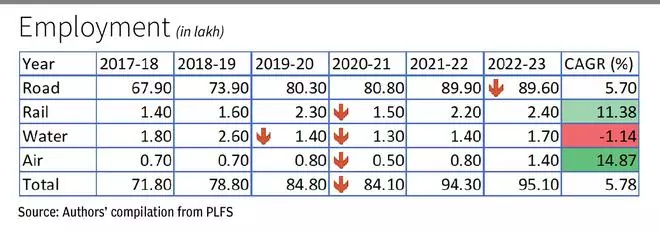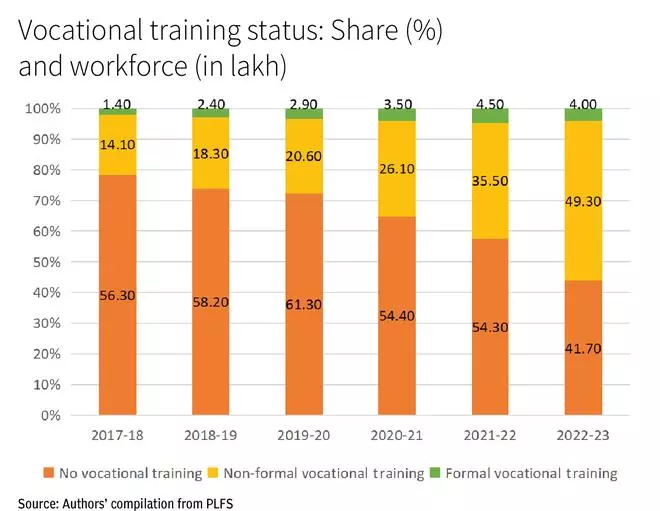The Government has initiated significant reforms to develop the freight logistics sector. The launch of the PM Gati Shakti National Master Plan for Multi-modal Connectivity in 2021, followed by the National Logistics Policy in 2022, emphasises coordinated and integrated planning among various sub-sectors and associated ministries within the logistics sector to enhance efficiency and outcomes. In a recent study for the CII-Institute of Logistics on employment trends and skill levels across India’s freight logistics sector, we found strong signs of employment recovery and demand for a skilled workforce post-Covid.
The Periodic Labour Force Survey (PLFS) data (see Table) reveals notable growth in employment within India’s freight logistics sector across different transport modes from 2017-18 to 2022-23, despite disruptions due to the Covid-19 pandemic.

The pandemic’s adverse impact was evident in 2020-21, as employment stagnated in the road transport sector, the largest sub-sector, while employment in rail, air, and water transport declined. This downturn led to a slight dip in overall employment, from 84.8 lakh in 2019-20 to 84.1 lakh in 2020-21, before the sector embarked on a robust recovery in subsequent years fuelled by steady growth in road transport and accelerated expansion in rail and air transport.
Total employment in the sector expanded from 71.8 lakh in 2017-18 to 95.1 lakh in 2022-23, underscoring a robust post-pandemic recovery, with a compound annual growth rate (CAGR) of 5.78 per cent.
Increased demand
A positive change in employment signals an increase in demand, indicating the pre-condition under which skills shortages are likely to occur. The skills gap acts as a critical barrier to employment transitions, hindering individuals entering the workforce or shifting from traditional sectors like agriculture to the freight logistics sector. The share of individuals with no vocational/technical training (mostly concentrated in the road sub-sector) has decreased significantly from 78.41 per cent in 2017-18 to 43.89 per cent in 2022-23 (see figure), indicating a growing engagement in vocational/technical training, especially a shift towards non-formal training whose share increased from 19 per cent to 52 per cent during 2017-18 to 2022-23. Sources of non-formal vocational/technical training include hereditary skills, self-learning, learning on the job, and other informal learning methods.

The positive rise in formally vocationally trained workers from 1.40 lakh workers in 2017-18 to about 4 lakh workers (about 4.2 per cent of the total workforce) in 2022-23 was modest, suggesting that formal skilling programmes are still underutilised despite their potential benefits. The shift in the share of vocationally trained workers highlights the growing importance and requirement of vocational/technical training, indicating a positive trend towards upskilling and reskilling within the freight logistics workforce. However, the low uptake of formal training continues to pose challenges.
As India strives to improve its global logistics ranking, addressing these skill gaps becomes imperative. The Logistics Sector Skill Council and the National Logistics Policy are critical to building a skilled workforce in the sector. Expanding formal vocational training programmes like the Pradhan Mantri Kaushal Vikas Yojana and improving access, especially in regions with high youth unemployment, is crucial to reducing the skills gap. Increasing awareness and tailoring these programmes to specific logistics sub-sectors that adopt a hybrid training model combining online learning with practical sessions can reduce employee absences and improve their relevance and effectiveness.
Apprenticeship programmes
Promoting formal e-learning platforms and encouraging the uptake of online certification programmes will help workers stay up-to-date with skill requirements in the logistics industry. Additionally, improving trainer quality through certification, upskilling, and involving industry experts in training efforts are essential steps. The government should also revamp apprenticeship programmes to match current industry needs better, offering better incentives for both employers and participants.
However, the development of the freight logistics sector and the success of workforce skilling programmes depend on improving working conditions and fostering inclusivity. Initiatives like targeted skills training for women, gender-sensitive workplace policies, and flexible work arrangements can help narrow the sector’s gender gap, which remains dominated by rural male workers. Women’s participation remains limited and mainly in urban areas.
Moreover, policies should aim to reduce informality in the freight logistics sector. With high levels of self-employment, casual labour, the absence of formal job contracts, and the prevalence of small firms, establishing regulations that protect workers’ rights and welfare is essential. Policies aimed at formalising employment contracts, expanding social security coverage, and ensuring minimum wage protections will enhance the overall job quality in the sector, making it more appealing to job seekers seeking stable and rewarding employment opportunities.
Gopal is Assistant Professor, and Brinda is Professor, Madras School of Economics, Chennai








Leave a Comment